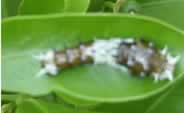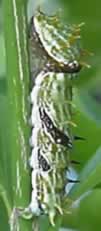Survival

Camouflage
Like stick insects, caterpillars of the Orchard Butterfly have evolved some very cunning ways to deceive their predators.
Camouflage is by far the most effective way of avoiding predators. The young caterpillars disguise themselves as bird-droppings and lie on citrus leaves fully exposed to any bird flying past. The caterpillar will shed its skin 4 times. The final time the caterpillar sheds its skin its colouration transforms into a green and brown pattern. It now avoids resting in the open and prefers to rest mostly in amongst the branches of the tree. It will rest upright on small branches.

The camouflage extends to the chrysalis where it disguises itself as a dry leaf.
Many insects hide under leaves and amongst the foliage of plants during the day in order to avoid predators. Why does the young caterpillar rest in the open on the top of leaves?

During very hot days the caterpillar rears up as shown in the picture on the left
Why do you think it behaves in this manner?
Look at its posture and suggest what effect it has on heat absorption.
Observation
During the Green stage how does the behaviour of the caterpillar change
from its behaviour when it was disguised as a bird dropping?